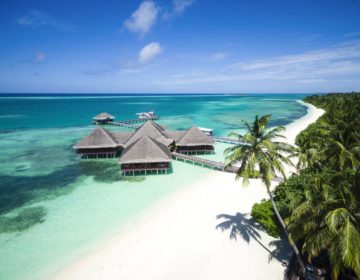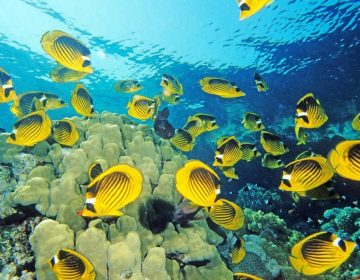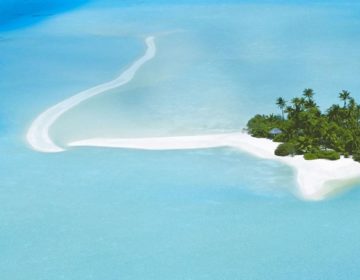South Maalhosmadulu Atoll and Goidhoo Atoll, or Horsburgh Atoll, as it is called on some European charts, belong to the administrative atoll of Baa. Weaving and fishing are the principal occupations of the Islanders. South Maalhosmadulu Atoll is 42 kilometers long and 32 kilometers wide. There are ten inhabited islands and 41 uninhabited islands, Eydhafushi is the atoll capital. The atoll is separated from North Maalhosmadulu Atoll by a 3.2 kilometers wide channel, Hani Kandu, otherwise known as the Moresby Channel. A 1.8 kilometers wide channel, Kuda Kanduohli, cuts through South Maalhosmadulu Atoll from east to west. There are six resorts on the atoll. Soneva Fushi (Kunfunadhoo), Reethi Beach (Fonimagoodhoo), Valtur Kihaad (Kihaadhuffaru) and Coco Palm Dhunikolhu. Four Seasons Resort at Landaa Giraavaru is the most recent resort constructed in 2006. Olhugiri is the most southern island of South Maalhosmadulu Atoll and lies 13 kilometers north of Goidhoo Atoll. Goidhoo Atoll, or Horsburgh Atoll, is 8.5 kilometers long and 17.5 kilometers wide. It has three uninhabited islands and only one channel, Doru Kandu, in the south of the atoll. The atoll offers secure anchorage near the islands in the north-east monsoon.

Bathalaa
Bathalaa is small and uninhabited with no coconut trees. It has plenty of sand surrounding the island and a long sandbank on the west side. It has full shallow lagoon with an excellent anchorage on the west side only a short swim from the island.
 Bathalaa Island
Bathalaa Island
Vinaneiyfaruhuraa
Vinaneiyfaruhuraa is little more than a coral and sand islet with no vegetation 50 meters in length on the outside corner of Vinaneiy Faru.
Voavah
Voavah is a small island resort by Four Seasons. There is an excellent beach on the west side, and the lagoon on the west side has a deep half-moon shaped bay with good access through the island’s outer reef making it ideal anchorage for deeper drafted dhonis. At either end of the island are sandbanks with good swimming and snorkeling.
 Four Seasons Voavah Resort
Four Seasons Voavah Resort
Kudarikilu
Kudarikilu is an inhabited with a shallow channel and a marker that cuts through the island reef to a very shallow lagoon on the west side. The island has plenty of coconut trees down to the shoreline. There is an old mosque and cemetery and a prominent lhoss tree near the beach on the north side. The old tree is a gathering point for children and islanders passing the time of day. Kudarikilu became known as ‘Bomuge Haadhisaa,’ or bomb island after a floating mine was found by fishermen in 1915 and towed to the island. As the curious islanders gathered around, they could not imagine the tragedy to follow after one of them began striking the strange, spiked object with a steel bar. The mine exploded killing nine people and injuring another 15.
Landaa Giraavaru
Landaa Giraavaru has been developed as a Four Seasons Resort at Landaa Giraavaru. It has a shallow lagoon one to three meters deep surrounding the island. Close by, on the south side is a well-protected anchorage with a sandy bottom at 13 meters. Large stands of staghorn coral and coral builders are spread over the bottom. Near the island, the sand forms a protective barrier around the anchorage on the outside. The site is ideal for night diving. Previously the island was used for picnics and had two disused and broken-down houses on the island.
 Landaa Giraavaru Island
Landaa Giraavaru Island
Kamadhoo
Kamadhoo is an inhabited island with a stick marking the shallow entrance to the inner lagoon on the west side of the island. There is also a small jetty. Fishermen can often be found repairing dhonis on the beach or saturating the timbers with fish oil; a smelly practice usually carried out when the wind is blowing the odor away from the island.
Milaidhoo
The reef around the resort of Milaidhoo has some patches of nice soft coral, and the island has good snorkeling all around with nice corals on the top reef.
Fonimagoodhoo
Fonimagoodhoo is now a resort called Reethi Beach (Fonimagoodhoo). It is a thickly vegetated island with a good beach and house reef on the west side. There is a deep house reef three to six meters on the east and north sides where many rock formations are located with stunning soft and hard corals. Turtles come onto the island to lay their eggs. There is a good anchorage at the east side, and on the south side a pearl-white beach drops off directly into deep water. Even deep drafted boats can come right on to the beach here.
 Reethi Beach Resort
Reethi Beach Resort
Finolhas
Finolhas is a beautiful heavily wooded island with tall coconut trees and is now a resort called Amilla Fushi.
Kihaadhoo
Kihaadhoo is an uninhabited island with a shallow channel marked by a buoy in the south-west side of the island. It has a narrow fringing reef 50 meters wide with a shallow lagoon around the island.
 Kihaadhoo Island
Kihaadhoo Island
Mudhdhoo
Mudhdhoo is a beautiful, well-vegetated island with lovely beaches all around. The island was once inhabited and contains the ruins of a mosque, two wells, and a cemetery. It is now a resort called Dusit Thani.
 Mudhdhoo Island
Mudhdhoo Island
Dhonfanu
Dhonfanu is an inhabited island with the anchorage on the north side.
Kidaahhuffaru
Kidaahhuffaru is now a resort called Kihaad. It is a more sparsely vegetated island with a small number of young coconut trees and has a beautiful beach surrounded by a medium sized lagoon.
Horubadhoo
Horubadhoo is a now a 200-bed resort called Royal Island. It is a large island thickly covered in lush vegetation to the water’s edge. There are many coconut trees, pandanus, and some 10-meter tall screw pine trees, which are rare in the Maldives. A small number of white-tailed tropic birds nest on the island and spend much of their time flying around the island and are identified by their long white tail feathers. The island is surrounded by a narrow beach and a healthy coral reef perfect for snorkeling and diving. The island was once inhabited, and the people are reported to have settled at Dhonfanu. There are the ruins of an old mosque and a bathing tank among the jungle and an ancient cemetery with tombstones, but no writing.
 Royal Island Resort
Royal Island Resort
Dharavandhoo
Dharavandhoo is a heavily timbered inhabited island with an old mosque and some early remains. The inhabitants of this island, like those from the other inhabited islands in Baa Atoll, produce handicrafts made out of screwpine leaves such as mats, fans, and lampshades for the Malé tourist market.
 Dharavandhoo Island
Dharavandhoo Island
Maalhoss
Maalhoss is an inhabited island with friendly people. It has a small lagoon on the western side offering shelter to shallow drafted vessels during the north-east monsoon. A pole with light marks the entrance. Large schools of herring swarm about the shallows and in the evening, the islanders fish for them with a short pole and line. The herring are then eaten or used bait for larger fish. The eastern side of the island is like a jungle and hidden in the middle is the Huraagandu, or island stone. This 60-centimeter-wide coral stone stood as high as a coconut tree until it broke off one meter from the ground about 20 years ago. No one knows the origin of the stone. A forked 70-year-old coconut tree is of particular interest and the area around the tree has been cleared, and islanders delight in taking visitors to the oddly shaped tree.
 Maalhoss Island
Maalhoss Island
Kunfunadhoo
Kunfunadhoo is a heavily timbered island 1.4 kilometers long by 400 meters wide. It originally opened as Kunfunadhu Island Resort in 1983 but was later closed, partly because of its isolation. It reopened as Soneva Fushi in 1995 and to improve comfort and reduce travel time, guest transfers to the island were by helicopter. Located 115 kilometers from Hulhule airport, it was the first development in the atoll. The island is surrounded by a sandy beach, and among the jungle areas, bird life, fruit bats, and lizards are prolific. Rabbits and chickens were later introduced to the island.
 Soneva Fushi Resort
Soneva Fushi Resort
Eydhafushi
Eydhafushi is the capital of the atoll and the focal point of transportation to Malé for smaller neighboring fishing communities. It has been inhabited for many centuries with the central mosque being built during the reign of Sultan Mohammed Mu-eenudheen I (1799 – 1835). The island is clearly distinguished by a large communications tower, visible for great distances at night by its flashing lights. The island has a hospital, school and a good harbor to serve the region.
 Eydhafushi Island
Eydhafushi Island
Kanifushi
Kanifushi is an uninhabited island with a picturesque sandy beach on the north side. It lies within the same reef system as Medhufinolhu, Ufuligiri, and two sandbanks. There is a 100-meter-wide barrier reef to cross to get to the deeper inside the lagoon. Entrance is at high tide over the unmarked reef on the north side of Kanifushi. Medhufinolhu has about 12 coconut trees, and Ufuligiri has some low bushy trees. The islands are connected at low tide. The island now has a resort called Finolhu.
Maamaduvvari
Maamaduvvari is a longer uninhabited island with a close fringing reef on the south-west side, and it has a beautiful moon-shaped lagoon with a sandy beach on the north-west side.
Hithaadhoo
Hithaadhoo is an uninhabited island lying in the middle of a circular reef. It has a wide lagoon on the south side, and the entrance is marked by a post on the north-west side of the reef. It is a fishing community, and the Islanders are well known for their piety in following the tenors of Islam.
Olhugiri
Olhugiri is the first island to come into view when approaching the atoll from the south. It is quite large and uninhabited, but well vegetated and a natural sanctuary for birds and turtles. It has a narrow fringing reef close to the island on the east and north sides with a deep channel close by on the eastern side.
 Olhugiri Island
Olhugiri Island
Thulhadhoo
Thulhadhoo is home to some craftsmen who produce handcrafted items with designs of red, black and yellow lacquer work.
 Red, black and yellow lacquer work of the craftsmen on Thulhadhoo
Red, black and yellow lacquer work of the craftsmen on Thulhadhoo
Dhunikolhu
Dhunikolhu is a resort called Coco Palm Dhunikolhu. Dhuni means bird.
Goidhoo
Goidhoo is the largest island in the Goidhoo group and being 1.6 kilometers wide and two kilometers long, it is relatively large by Maldivian standards. It is an inhabited island, and large deposits of sand and gravel in the center of the island suggest it has been inhabited for many centuries. It was made the exiles’ island in 1962, although some political prisoners and convicts are recorded as being banished here and at other islands in the group, since at least 1602. A strange event occurred in 1963 when thousands and thousands of flying-fish are recorded as having landed on the island.
 Goidhoo Island
Goidhoo Island
Fulhadhoo
There is a nice white sandy beach and a shallow lagoon with coral heads on the south side of this inhabited island. The island has plenty of vegetation. The Corbin was shipwrecked on the reef near Fulhadhoo on July 2, 1602, with Frenchman Francois Pyrard on board. The 40 survivors made it by boat to Fulhadhoo the following day but only four, including Pyrard, are known to have survived the five-year ordeal. Many of the survivors were held captive at Fulhadhoo and the other islands in the group during their time in the Maldives. The survivors buried silver from the wreck on Fulhadhoo, and one story told is that treasure was buried at the base of a large Nika tree. A group of Frenchmen in search of the treasure are said to have returned to the island many years ago but found no evidence of the Nika tree or treasure.
Fehendhoo
Fehendhoo is similar to Fulhadhoo in shape; it too has a shallow sandy lagoon with coral heads on the south side. On the western end of the lagoon, a long sandbar almost connects Fulhadhoo at low tide. The island is inhabited.
Innafushi
Innafushi is a small uninhabited island with some vegetation.
Maafushi
Maafushi is little more than a mound of coral with a light tower on the western side of Doru Kandu. There is no vegetation.
 Maafushi Island
Maafushi Island
Fehenfushi
There is little evidence of an island here, just coral rubble on the reef on the eastern side of Doru Kandu.
(Source: Dive Maldives: A guide to the Maldives Archipelago. Tim Godfrey. Atoll Editions)



